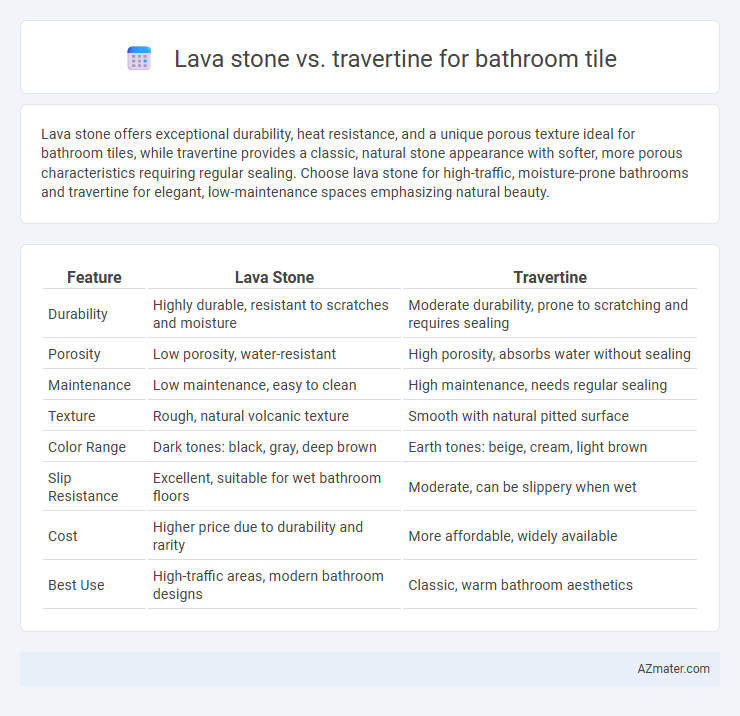Lava stone offers exceptional durability, heat resistance, and a unique porous texture ideal for bathroom tiles, while travertine provides a classic, natural stone appearance with softer, more porous characteristics requiring regular sealing. Choose lava stone for high-traffic, moisture-prone bathrooms and travertine for elegant, low-maintenance spaces emphasizing natural beauty.
Table of Comparison
| Feature | Lava Stone | Travertine |
|---|---|---|
| Durability | Highly durable, resistant to scratches and moisture | Moderate durability, prone to scratching and requires sealing |
| Porosity | Low porosity, water-resistant | High porosity, absorbs water without sealing |
| Maintenance | Low maintenance, easy to clean | High maintenance, needs regular sealing |
| Texture | Rough, natural volcanic texture | Smooth with natural pitted surface |
| Color Range | Dark tones: black, gray, deep brown | Earth tones: beige, cream, light brown |
| Slip Resistance | Excellent, suitable for wet bathroom floors | Moderate, can be slippery when wet |
| Cost | Higher price due to durability and rarity | More affordable, widely available |
| Best Use | High-traffic areas, modern bathroom designs | Classic, warm bathroom aesthetics |
Introduction: Lava Stone vs Travertine for Bathroom Tiles
Lava stone and travertine offer distinct advantages for bathroom tiles, with lava stone known for its durability, heat resistance, and natural textured surface that provides slip resistance. Travertine features a porous, elegant appearance with warm earth tones and classic veining, making it a popular choice for creating luxurious, timeless bathroom designs. Both materials require proper sealing, but lava stone generally demands less maintenance due to its dense composition compared to the more absorbent travertine.
Origin and Composition of Lava Stone
Lava stone, formed from cooled volcanic magma, originates primarily from regions with volcanic activity such as Italy, Indonesia, and Hawaii. Its composition is predominantly basalt, rich in iron and magnesium, giving it high durability and natural heat resistance, ideal for bathroom tiles. In contrast, travertine is a sedimentary rock formed from mineral deposits in hot springs and limestone caves, composed mainly of calcium carbonate, offering a softer, more porous surface.
Understanding Travertine: Formation and Properties
Travertine forms through the precipitation of calcium carbonate from mineral-rich thermal springs, resulting in a porous, sedimentary stone with unique natural veining and holes often filled for tile applications. Its earthy tones and textured surface provide excellent slip resistance, making it ideal for bathroom flooring and walls. The stone's durability and ability to withstand moisture, combined with its hygroscopic properties that regulate humidity, enhance bathroom comfort and longevity.
Key Aesthetic Differences
Lava stone bathroom tiles exhibit a rugged, volcanic texture with natural dark hues ranging from deep black to charcoal gray, creating a bold, earthy ambiance. Travertine tiles showcase a smooth, porous surface with warm, neutral tones such as beige, cream, and honey, offering a classic, elegant look with natural veining and pits. The key aesthetic difference lies in lava stone's dramatic, textured appearance versus travertine's soft, refined, and timeless beauty.
Durability and Longevity Comparison
Lava stone offers exceptional durability due to its volcanic origin, making it highly resistant to scratches, heat, and moisture, which is ideal for bathroom environments. Travertine, while visually appealing with its natural porous texture, requires regular sealing to maintain its longevity and prevent water damage or staining. In terms of long-term performance, lava stone generally outlasts travertine in bathrooms, providing a more robust and low-maintenance flooring option.
Water Resistance and Porosity
Lava stone offers superior water resistance compared to travertine due to its dense, volcanic composition, making it an excellent choice for bathroom tiles in high-moisture environments. Travertine, a sedimentary limestone, has higher porosity and requires sealing to prevent water absorption and potential damage from prolonged exposure. Selecting lava stone can reduce maintenance and enhance durability in wet bathroom settings, while travertine may need more frequent sealing to maintain its structural integrity and appearance.
Maintenance and Cleaning Requirements
Lava stone tiles require minimal maintenance due to their natural durability and resistance to stains, but they benefit from periodic sealing to prevent water absorption and ensure longevity. Travertine tiles need more careful maintenance, including regular sealing and gentle cleaning with pH-neutral products to avoid etching and surface damage caused by acidic or abrasive cleaners. Both materials offer unique aesthetic benefits, but lava stone is generally more practical for high-moisture bathroom environments due to its lower upkeep demands.
Slip Resistance and Safety
Lava stone tiles offer superior slip resistance for bathrooms due to their naturally rough and porous surface, making them a safer choice in wet areas compared to smooth travertine. Travertine, while aesthetically pleasing with its polished finish, tends to be more slippery when wet, raising safety concerns without proper sealing and anti-slip treatments. Prioritizing slip resistance, lava stone tiles provide enhanced traction and durability, reducing the risk of slips and falls in bathroom settings.
Environmental Impact and Sustainability
Lava stone boasts a lower environmental impact due to its natural abundance and minimal processing requirements, making it a highly sustainable choice for bathroom tiles. Travertine extraction involves more intensive quarrying and chemical treatments, which increase its carbon footprint and environmental degradation risk. Choosing lava stone supports eco-friendly practices by reducing resource consumption and promoting durability in bathroom applications.
Cost Analysis and Value for Money
Lava stone tiles typically cost between $10 and $20 per square foot, offering durability and natural heat resistance, while travertine tiles range from $3 to $7 per square foot, providing an affordable yet elegant option. Lava stone's long lifespan and resistance to moisture enhance its value for money despite higher upfront costs, making it suitable for wet bathroom environments. Travertine offers a classic aesthetic with moderate maintenance needs, appealing to budget-conscious homeowners seeking style without a high initial investment.

Infographic: Lava stone vs Travertine for Bathroom tile
 azmater.com
azmater.com